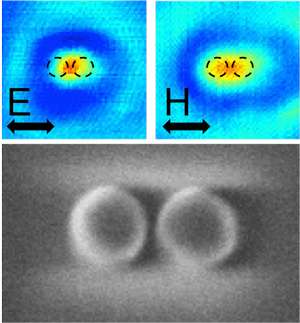Pairs of silicon nanocylinders can locally create and enhance light's magnetic field

Shining visible light on two tiny silicon cylinders, or a 'nanodimer', placed just 30 nanometers apart, produces resonant hot spots for both the electric and magnetic fields, finds a study by A*STAR researchers. This phenomenon could potentially be used to connect computing devices.
Earlier theoretical work had predicted the existence of such magnetic hot spots, but this is the first time that they have been observed experimentally with visible light in a nanodimer configuration (see image), according to lead author Reuben Bakker from the A*STAR Data Storage Institute. The researchers numerically calculated the expected electric and magnetic resonances and found good agreement with the experimental results.
The use of light to carry information, known as photonics, is critical to the continued growth of information technology. Unfortunately, the diffraction limit of light restricts it from being directed at dimensions smaller than half its wavelength, which imposes a limit on the minimum sizes of photonics-based devices.
The use of plasmon resonances in metals—resonant collective oscillations of conduction electrons—has been proposed as a way to overcome this limit. However, metals that support plasmons are often 'lossy', which means that the distance the light can travel in them is quite limited.
"Typically in metal photonics, researchers have been studying the electric field," says Bakker. "But we are now looking at materials in the subwavelength regime (below the diffraction limit), where we can create and manipulate the magnetic field as well. Essentially, the electric field creates a current loop inside the nanoparticle and this current loop creates the magnetic resonance."
Being able to manipulate the magnetic field close to the nanodimer provides "another lever to pull so that light does what we want it to do," says Bakker.
To exploit this effect, the nanoparticles need to be made of a high-dielectric-constant material, such as silicon.
"We've taken the silicon direction because it has a high refractive index and doesn't have the losses that metals do," says Bakker. "But silicon may not be the final answer. We know how to work with silicon because of the integrated circuit industry and it is good—but is it the best? We're still figuring that out."
Bakker sees this work as a step toward more complex systems that could potentially end up as being nanoantennas or waveguide systems. "This nanodimer is an intermediary—it's not the most useful device in itself. We have to build up our understanding of these systems on an incremental basis," he says.
More information: "Magnetic and electric hotspots with silicon nanodimers." Nano Letters 15, 2137–2142 (2015). dx.doi.org/10.1021/acs.nanolett.5b00128
Journal information: Nano Letters




















